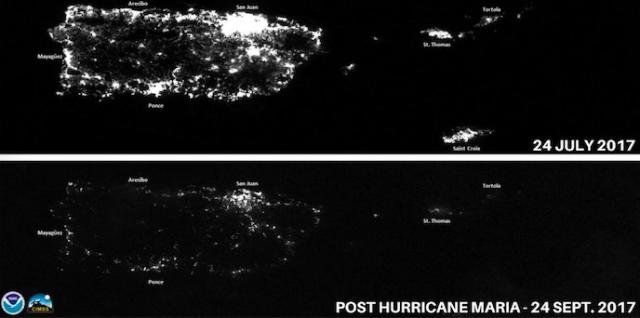This article was written on assignment for Salon.com magazine
 Night satellite images of the island of Puerto Rico taken before and after it was hit by two major hurricanes
Night satellite images of the island of Puerto Rico taken before and after it was hit by two major hurricanes
It’s been a week since Puerto Rico, the American-owned island colony of 3.4 million, was destroyed by the second of two Category 5 hurricanes that struck it within a brief two-week period earlier this month.
Yet as of today, although virtually all the island’s local farms were destroyed by Hurricane Maria, its electric grid almost totally taken down, its cellular phone system destroyed, its water and sewer systems rendered inoperable and its roads made impassable, and although lack of communications and ability to travel has meant that the fate of millions in the island’s hinterlands and mountains is still unknown to family and friends in San Juan and on the US mainland, the US government in Washington has done almost nothing concrete to bring real, desperately needed help or even food and medicine to the island.
This stands in stark contrast to the aid Washington rushed immediately to Houston and to southern Florida in the wake of Hurricanes Harvey and Irma.
President Trump has cited the island’s technical insolvency (its economy was crushed by the Fiscal Crisis that began in 2008 and by the ensuing Great Recession and its government and various public agencies have been unable to make payments on over $72 billion in bond debt), as being the people’s and their government’s fault. But Puerto Rico, as a colony subject to the rule of Congress and to US federal courts, is not permitted the same recourse of entering into bankruptcy and renegotiating its debt as public agencies and municipalities in the US can do.
Trump alluded to that debt in an incredibly insensitive comment, tweeting: “Texas & Florida are doing great but Puerto Rico, which was already suffering from broken infrastructure & massive debt, is in deep trouble.”
He has also blamed the significant lack of aid coming from the US on Puerto Rico’s being an island. As the president put it in a Tuesday tweet: “This is an island sitting in the middle of an ocean. And it’s a big ocean; it’s a very big ocean. And we’re doing a really good job.”
Left unsaid by the president is that Congress has long made transporting goods to Puerto Rico astoundingly difficult and expensive, dating back to the Jones Act. That law passed in 1929 requires, among other things, that all shipping between US ports be done on US-flagged and US-built ships, which of course are among the most costly in the world to operate (and there aren’t many of them). The act includes Puerto Rico’s ports, too. And in Puerto Rico’s case it also imposes huge tariffs on goods imported to Puerto Rico from other countries, like neighboring Dominican Republic, Venezuela, Colombia, etc., which are in a good position to deliver aid if they could. (Cuba also stands ready to aid Puerto Rico with both food and medical assistance as it did during the Haiti earthquake, but that is not even permitted by the US.)
When Puerto Rico’s government asked for an emergency exemption from the Jones Act, so that any ship from any nation could deliver needed supplies of medicine, food, water, fuel and emergency equipment like generators and rescue equipment, including from US ports, the Trump administration flatly refused Yet his administration readily waived the act for both Houston and Florida after hurricanes hit there….
For the rest of this article, please go to: Salon.com magazine
